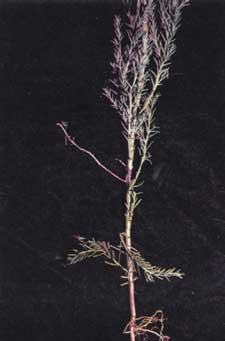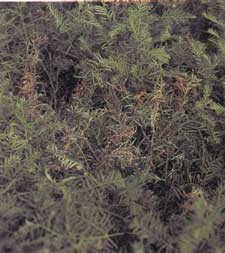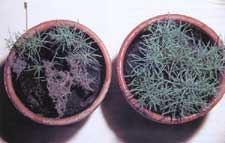Gray MoldMichael D. Srago - Regeneration Specialist, Region 5, USDA Forest Service, San Francisco, CA, and Cordell C.E., Anderson R.L., Hoffard W.H., Landis T.D., Smith R.S. Jr., Toko H.V., 1989. Forest Nursery Pests. USDA Forest Service, Agriculture Handbook No. 680, 184 pp. Hosts Gray mold, caused by the fungus Botrytis cinerea (sexual state: Botryotinia fuckeliana), has an extremely large number of hosts. In fact, nearly all forest tree seedlings are susceptible to some degree; but redwood, giant sequoia, and Monterey and Italian cypress are especially susceptible. Distribution Gray mold is found in all the temperate regions of the world. Damage Gray mold occurs sporadically in nurseries and greenhouses. In less susceptible species, losses are often confined to pockets of seedlings, but the disease can cause heavy mortality in highly susceptible species such as giant sequoia. The disease also can originate or continue in storage facilities and transit, especially if temperatures are above 32 oF.
Moisture is often a more limiting factor in disease development than temperature: the spores of the fungus require free water to germinate. The disease is favored by cultural practices, such as high planting densities or lath shading, that limit air movement and raise the humidity around the seedling. Control Cultural - Modify the environment to increase aeration and decrease humidity around the seedlings; this will reduce spore germination and growth of the fungus. Beneficial cultural practices include reducing seedling density, improving air circulation, and irrigating less frequently or in the early morning. Chemical - Numerous fungicides- including benomyl, chlorothalonil, and DCNA or dicloran-are effective. However, Botrytis has developed strains resistant to some fungicides, especially the systemic benzimidazole fungicides such as benomyl. Use several different fungicides, preferably with different modes of action, in rotation. Standard spray programs for Botrytis in California and the Pacific Northwest involve foliar fungicides applied at 1- to 2-week intervals in greenhouses and at 2-to 4-week intervals in bareroot nurseries. Selected References Coley. JR.; Verhoeff, D.; Jarvis, W.R. 1980. The biology of Botrytis. London, England: Academic Press. 318 p. Ellis, M.B. 1971. Dematiacious hyphomycetes. Kew, England: Commonwealth Mycological Institute. 608 p. Halber, Max. 1963. Botryris sp. on Douglas. fir seedlings. Plant Disease Reporter. 47: 556. Smith, Richard S.; McCain, A.H.; Srago. M.D. 1973. Control of Botrytis storage rot of giant sequoia seedlings. Plant Disease Reporter. 57: 67-69. |
Forest Pests: Insects, Diseases & Other Damage Agents |

|
|




